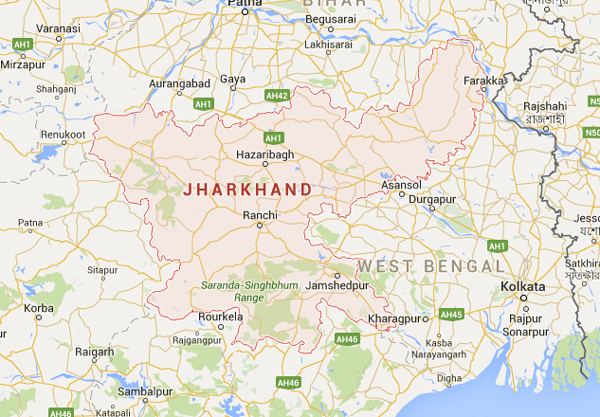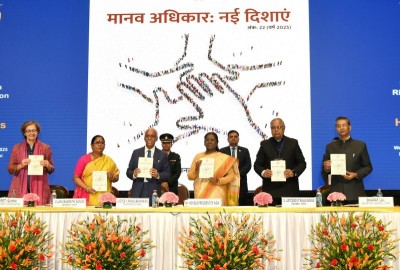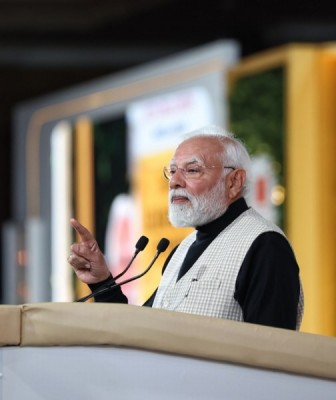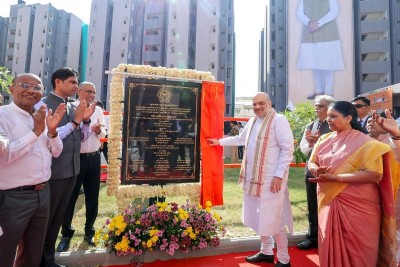
Jharkhand: Tragic Errors, Sustained Consolidation
State Director General of Police (DGP) D.K. Pandey admitted to critical Police lapses during the combing operation: "While carrying out operations in a remote area, the Police should have used an anti-landmine vehicle instead of moving around in a Tata 407 mini truck. Adequate backup for unprecedented eventualities was also not taken care of."
The DGP's observation that the Forces should have used anti-landmine vehicles itself seems questionable. It is useful to recall that then CRPF Director General Vijay Kumar, on October 11, 2011, had indicated that the paramilitary force needed to find better ways to counter hidden improvised explosive devices (IEDs), as the Mine Protected Vehicles (MPVs) had become "coffins on wheels" in Naxal [Left Wing Extremism, LWE]-hit states. Standard Operating Procedures (SoPs) require all units in Naxal-affected areas to patrol on foot, and to use MPVs only in very rare instances.
Indeed, a procedural failure led to the January 27 debacle, the first major attack (resulting in three or more fatalities) specifically targeting SFs in the State recorded since July 2, 2013, when Pakur District Superintendent of Police (SP) Amarjit Balihar and five other Policemen were killed in an ambush by CPI-Maoist cadres in the Kathikund Forest area of Dumka District. Balihar was returning from a meeting with Deputy Inspector General (DIG) Priya Dubey in Dumka when his vehicle was attacked by the Maoists. Another three were injured in the incident.
There was, however, another intervening incident of an attack on an election party, in which eight persons, including five Police personnel, two election officials and one cleaner, were killed and another 10 injured, when CPI-Maoist cadres exploded a landmine targeting a poll bus near Sarsa village under Shikaripara Police Station of Dumka District soon after voting for the Lok Sabha (Lower House of Parliament) elections ended on April 24, 2014.
On the other hand the SFs have carried out at least three such major attacks since July 2, 2013. The Maoists suffered their biggest loss when 12 of their cadres were killed in an encounter with the Palamau District Police and a team of Commando Battalions for Resolute Action (CoBRA) personnel in Palamau District on June 9, 2015.
Through 2015, according to partial data compiled by the South Asia Terrorism Portal(SATP), SFs killed at least 24 LWE cadres in the State, while losing five of their own personnel, yielding a ratio of nearly 1:5. Of the remaining 13 LWE fatalities, 12 were killed in factional clashes while another was killed while planting a landmine.
In a booklet released on December 23, 2015, the State Police claimed that four Policemen were killed as against 42 LWEs in 2015 - 24 in Police encounters, three by civilians, and 15 in factional clashes. A huge amount of explosives and weapons were recovered, while the Police lost no weapon. Further, 400 Naxalites, including as many as 37 in the ranks of 'area commander' and above, were arrested during sustained anti-Naxal operations through 2015. Also, for the first time since 2011, there was not a single Naxalite attack on a Police Station in Jharkhand.
State Additional DGP (Operation) S. N. Pradhan observed,
The year saw the Police targeting the top and middle level leaders in the Maoist ranks through arrests or their neutralization. The mounting pressure hit hard on the Maoists as they lost on cadres while new cadres did not join them. This was an outstanding year. These were the biggest achievements during the last 10 years. LWE violence would be nearly wiped out in the next two-three years through sustained operations.
Indeed, LWE violence in the State is at its lowest level, as, indeed, across the country. According to SATP data, as against 97 fatalities, including 48 civilians, 12 SF personnel and 37 militants, recorded in 2014, 2015 saw 58 such fatalities, including 16 civilians, five SF personnel and 37 militants. This was the lowest number of SF fatalities since 2007, when six personnel were killed. More importantly civilian fatalities, at 16 through 2015, were also the lowest since 2006, when 18 civilians had been killed.
Unsurprisingly, other parameters of violence also recorded significant declines. According to the SATP database, the Maoists engaged in at least 14 incidents of arson in eight Districts - Latehar (2), Palamu (3), Hazaribagh (2), Garwah (3), Bokaro (1), Ranchi (1), West Singhbhum (1) and Seraikela Kharswan (1) through 2015; as against 12 such incidents in eight Districts in 2014. In 2015 LWE groups were involved in three blasts in three Districts - Deoghar, Hazaribagh and Lohardaga - in comparison to eight blasts in four Districts - Bokaro (3), Giridih (2), Latehar (2), and Hazaribagh (1) in 2014. There were four recorded cases of abduction in 2015, against five such cases in 2014.
An analysis of Maoist violence, as well as of overground and underground activities in Jharkhand through 2015 indicates that a total of 11 Districts, including East Singhbhum, West Singhbhum, Giridih, Gumla, Hazaribagh, Khunti, Palamu, Ranchi, Latehar, Simdega, and Lohardaga remain highly affected; six Districts - Bokaro, Chatra, Seraikela-Kharswan, Godda, Garwah and Dumka, are moderately affected; while five Districts - Dhanbad, Ramgarh, Koderma, Deoghar and Pakur, are marginally affected by LWE activities. The number of affected Districts remained the same as in 2014, though there has been significant movement between categories. According to Police data, for the second year in a row, the Maoists could not hold any 'people's court' in any part of the state.
In another positive development during the course of the year, the second Panchayat(village local bodies) election was conducted in the State, with voters giving a clear electoral rebuff to the Maoists, turning out in large numbers. Despite a poll boycott call by the Maoists, the voting percentage stood at a high 72 per cent. Moreover, during the four phase Panchayat election held from November 22 to December 12, 2015, there was negligible LWE violence recorded in the State, with media reports indicating just two arson incidents and one civilian killing. The first Panchayat election, a five phase election, conducted between November 27 and December 24, 2010, had seen much higher levels of LWE violence, though the voting percentage was high even then (70 per cent).
Jharkhand has clearly secured remarkable successes in its fight against LWE through 2015, a narrative that is now common to most of the Naxal-affected States in India. In terms of Naxal-related fatalities recorded on a year on year basis, barring Chhattisgarh and Telangana, where there has been a marginal increase, there have been dramatic improvements everywhere, the result of a steady erosion of Maoist capacities and capabilities, overwhelmingly as a result of a sustained loss of leadership over the past decade. These gains have been consolidated by fitful improvements, marred by occasional fiascos, in SF operations.
The new Bharatiya Janta Party (BJP)-led National Democratic Alliance (NDA) State Government had made its intent clear in the beginning of 2015. Indicating a tough stance, Jharkhand Chief Secretary Sajal Chakarabarty described the fight against LWE as a war and asserted, on January 14, 2015,
There is no time to surrender now. That train has left the station. If you want to get in, run and try. In three months, there will be no active Naxal activity here. For me, the best Naxalite is a dead Naxalite.
Days later, echoing the same view, Chief Minister (CM) Raghubar Das had said his Government will "rise to the challenge" posed by insurgents and "decimate extremism and CPI-Maoist violence in the state within six months".
To realize this intent, the Government took measures to strengthen the Police Force. Jharkhand Police has around 4,200 officers [from Assistant Sub Inspector (ASI) to Director General (DG)] as against around 47,000 men (including Constables, Head Constables and Grade 4), yielding a teeth to tail ratio of 1:4.95. The State Police booklet released on December 23, 2015, stated that it had been decided to increase the number of Officers to 5,958 with an equivalent reduction in posts of Constables. The Government decided to improve infrastructure in 33 Urban Police Stations in financial year (2015-2016) and 50 Police Stations are to be taken up every year thereafter. However, no information is available regarding implementation of targets set for financial year 2015-2016. Changes have also been made in the training program, including a decision that the entire constabulary would undergo Firing and Field Craft Training every year. A January 5, 2016, report suggested that five Additional SPs, who will lead the anti-Maoist operations, were likely to be deployed in LWE-hit Districts to ensure 'prompt and smooth conduct of operations'. Meanwhile, on January 27, 2016, the Central Government cleared the creation of 17 new Indian Reserve Battalions (IRBs), including three for Jharkhand. At present, Jharkhand has 24 battalions of central forces, including 20 CRPF battalions, two Sashatra Seema Bal (SSB) and two of CRPF's special strike force, CoBRA.
While operational pressures have been built up against the Maoists, the Government also amended the 2009 Surrender and Rehabilitation Policy in March 2015, making it more lucrative for those who were willing to abjure violence and return to the 'mainstream'. According to the amended Policy, surrendered cadres were to be divided into two categories - 'A' and 'B'. Those falling into the 'A' category would receive a rehabilitation grant of INR 500,000; while 'B' category cadres would receive INR 250,000. Though no authentic number is available, Chief Minister Das claimed that the surrender policy for the LWEs has been redesigned and as a result, the number of surrendering Naxalites had increased. Meanwhile, to encourage further surrenders, the Jharkhand Police is mulling the dropping of criminal cases against cadres if they gave themselves up. According to the December 2015 Police booklet, "The best possible incentive for Naxal surrenders could be a complete withdrawal of cases. In this light the Police Department with support of the Government has begun to seriously consider the legal issues in withdrawing prosecution against those top Naxals who are willing to surrender. The Police is also trying to recruit in the Police force those formerNaxals who have been absolved by courts and/ or who are in the surrender process."
Despite occasional setbacks such as the January 27, 2016, attack, the Government's carrot and stick policy appears to be working. Nevertheless, the Maoists continue to carry out lethal attacks intermittently. The core of the State's approach was, however, defined by State DGP D.K. Pandey, when he declared, "taking lessons from yesterday's [January 27, 2016] blast, the Police will carry on further operations against the rebels in the State." Errors and consequent losses are, perhaps, inevitable in protracted operations; but if the will and clarity of purpose remain, Jharkhand could stand out as an example for neighboring States like Chhattisgarh, where the Maoists retain their greatest strength.
Support Our Journalism
We cannot do without you.. your contribution supports unbiased journalism
IBNS is not driven by any ism- not wokeism, not racism, not skewed secularism, not hyper right-wing or left liberal ideals, nor by any hardline religious beliefs or hyper nationalism. We want to serve you good old objective news, as they are. We do not judge or preach. We let people decide for themselves. We only try to present factual and well-sourced news.







